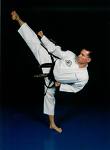Translate This Page
Karate can best be described as a form of martial arts, though many people consider it to be a sport as well. Karate originated in Okinawa, Japan from several original fighting styles combined with Chinese Kenpo. Karate Moves consist of punches, kicks, knee hits, elbow hits, open hand techniques, locks and restraints, and throws. Karate is believed to have first been practiced before the 19th century where it slowly grew in popularity and made its way to the Japanese mainland as well. The first official Karate club was established in 1924, further popularizing the sport. By the 1960s and 1970s, martial arts were so popular that they appeared in several Hollywood movies. This caused another large growth in popularity, and martial arts schools began to pop up all over the world. Today, people young and old and from all over the globe change into special uniforms and practice their Karate Moves at a variety of different skill levels.
Most people who currently practice Karate do so in one of three ways. These include Budo, which is where Karate is looked upon as an art form; athleticism where Karate is considered a combat sport or a solo sport; or as a form of self defense and/or exercise. Those who practice Karate as an art also practice it as a form of spiritual enlightenment and are closest to the practice’s original intentions. Other forms of Karate practice may emphasize confidence and perseverance but mostly focus on physically performing various Karate Moves.
For any person interested in studying Karate, it is important to first decide which way to practice the sport. Those interested in learning the sport as a genuine art form will not want to put too much focus on the actual Karate Moves. Instead, they will want to start slowly, learning about the origins and the psychological and emotional emphasis of the martial art. The moves will come until later. For those interested in practicing as a sport, or as self defense or exercise, it’s all about the Karate Moves, and a different kind of class will need to be sought out. The best way to get a feel for any particular class is to talk to the instructor about the main goals of the specific class. Also, most martial arts schools and training centers allow prospective students to either observe or participate in one introductory class free of charge. It is usually in the potential student’s best interest to take advantage of this offer in order to know for sure if a particular class is the right fit. Once a student has the right class to match the student’s interest, there’s no limit to how much can be learned or how long the student may practice.

"WHERE THERE IS PREPERATION THERE IS NO FEAR"
The Karate CC uses is rooted in the Hyungs of Moo Duk Kwan consisting of over 30 different patterns recording the possible applications of each hyung used in hand to hand and empty hand against weapons.
Korean terminology for pattern or form = Hyung............Japanese = Kata
Chilsung Il ro this Hyung is the form used for yellow belt in Complete Combat
Chilsung Sam ro Hyung is used for Green belt in Complete Combat.
Chilsung Oh ro Hyung is used for Red belt in Complete Combat.
Chilsung Chil ro Hyung is used for Second Dan Black Belt in Complete Combat.
Having attended many of Iain Abernathy seminars Complete Combat consider Iain to be one of the worlds newest leading innovators of the study of Bunkai..[usage and understanding of kata applications.] We strongly reccomend collecting Iains books,DVD, and other sources he has put together to open a window of understanding why martial arts was recorded in kata form.
Chilsung yi ro this Hyung is the form used for orange belt in Complete Combat.
Chilsung Sah ro Hyung is used for Blue belt in Complete Combat.
Chilsung yuk ro Hyung is used for first Dan Black belt in Complete Combat.
Kong Song Koon Hyung is used for Third Dan Black Belt in Complete Combat.
Some regard Complete Combat as brutal fighting system,here it is beautifully demonstrated in Art form.The hidden potential within kata as demonstrated by these karateka women